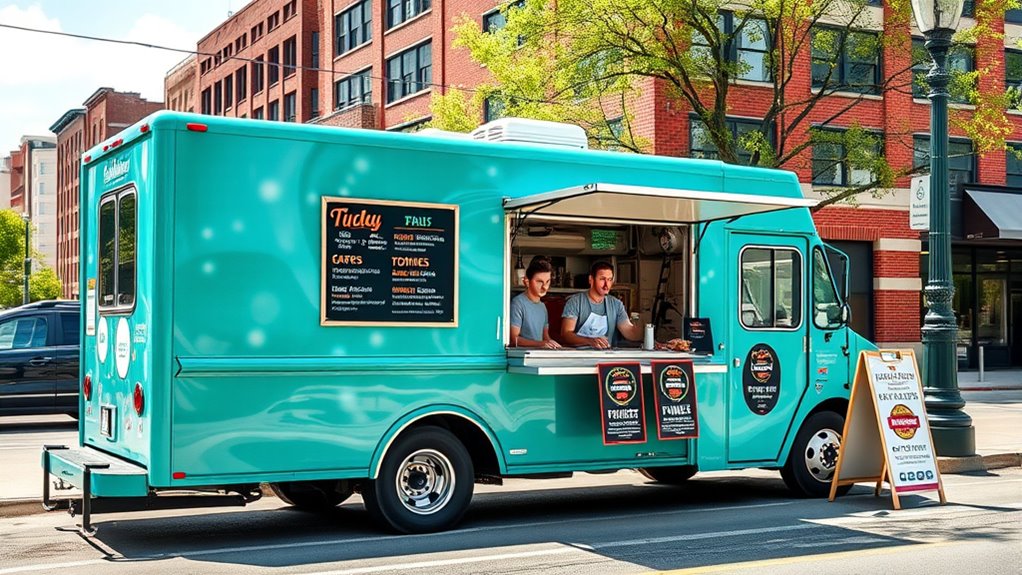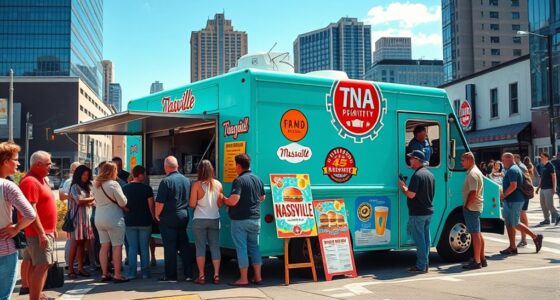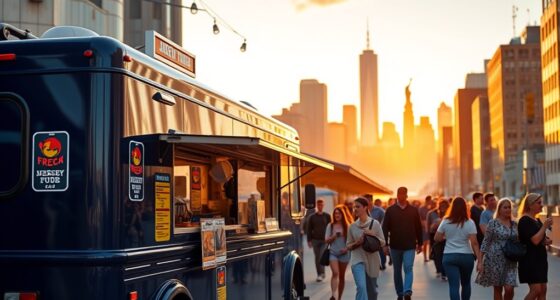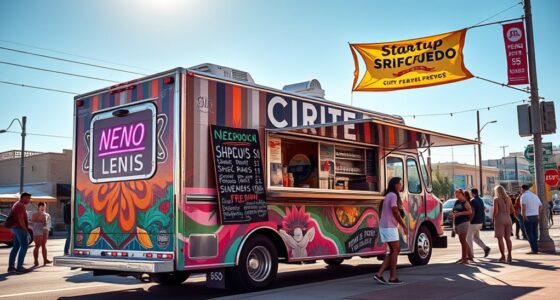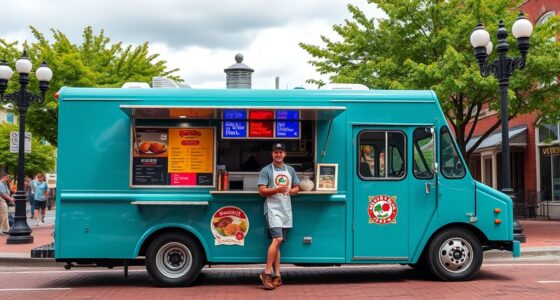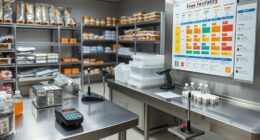To open a food truck in Indianapolis, you need to secure statewide and local permits, plan for startup costs between $50,000 and $200,000, and choose high-traffic locations that comply with zoning laws. Design a menu that stands out, and use social media to promote your brand. Ensuring food safety and vehicle compliance is key. If you keep exploring, you’ll find detailed steps to launch and grow your mobile food business successfully.
Key Takeaways
- Obtain statewide and local health permits, submit operational plans, and comply with safety regulations for legal food truck operation.
- Budget $50,000–$200,000 for truck purchase, equipment, permits, and initial inventory; consider new, used, or rental options.
- Choose high-foot-traffic locations like parks, events, and business districts with proper permissions and use agreements.
- Develop a simple, appealing menu featuring signature dishes, seasonal items, and unique cuisine to attract diverse customers.
- Leverage social media and community events for marketing, sharing high-quality visuals, promotions, and building local brand awareness.
Navigating Permits and Licensing Requirements in Indianapolis
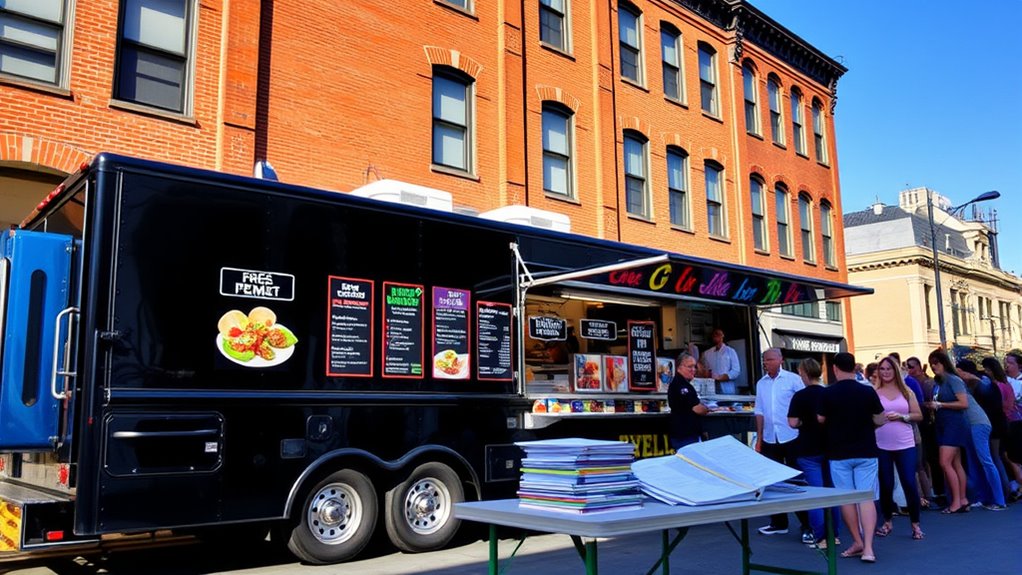
Understanding permits and licensing requirements in Indianapolis is a straightforward process if you comprehend the key steps involved. First, you’ll need to obtain a statewide mobile retail food establishment license under House Enrolled Act 1577 (2025). This license allows you to operate across Indiana counties without needing separate local licenses. The application and license fees are capped at $450, making costs predictable. Local health departments in Indianapolis will issue your permits, conduct semiannual inspections starting in 2027, and collect fees, which are typically around $325 to $375 depending on your vehicle type. Before opening, you must submit a detailed operational plan at least 30 days in advance, covering your menu, equipment, and layout. This ensures your food truck complies with state and local health regulations and is ready to serve customers safely. Additionally, the legislation streamlines licensing procedures, reducing administrative burdens for vendors and promoting easier entry into the market. It is also important to stay informed about tire pressure considerations to ensure your vehicle’s optimal performance and safety during operations.
Understanding Costs and Budgeting for Your Mobile Food Venture
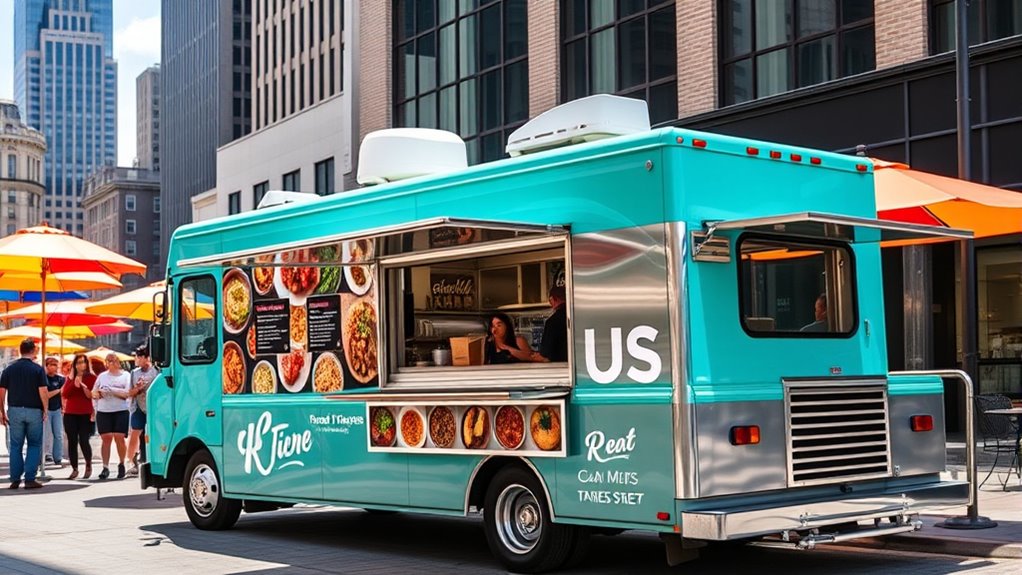
Starting a mobile food business in Indianapolis requires careful budgeting to make certain you allocate enough funds for each essential aspect. Your initial capital can range from $50,000 to $200,000, depending on truck condition and customization. Buying a new truck costs between $75,000 and $150,000, while used trucks are more affordable at $40,000 to $80,000. Renting a truck is an option at $2,000 to $3,000 monthly, with additional costs for kitchen equipment, branding, and retrofitments, totaling $5,000 to $20,000. Licensing and permits in Indianapolis are surprisingly affordable, around $590. Expect to spend $2,000 to $3,000 on initial inventory and roughly $1,000 to $1,200 monthly on utilities. Budget for marketing, staffing, insurance, and maintenance to guarantee a successful launch. Indianapolis permits and licensing costs are among the lowest in major U.S. cities, making it easier for new entrepreneurs to enter the market without excessive initial expenses. Additionally, understanding costs and budgeting strategies is crucial for maintaining profitability and ensuring long-term success.
Choosing the Right Locations and Zoning for Maximum Visibility
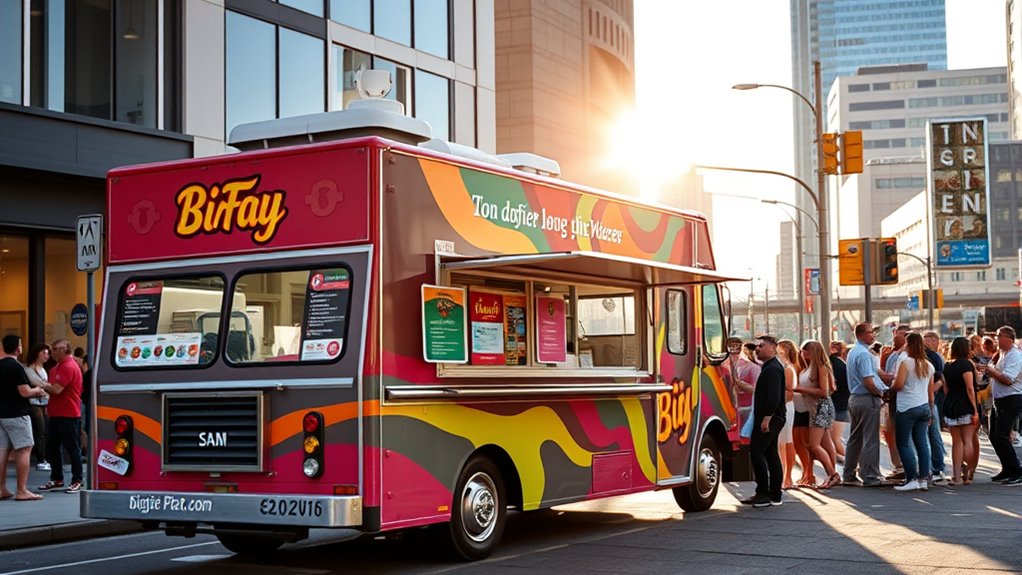
Choosing the right locations and guaranteeing proper zoning are crucial steps to maximizing your food truck’s visibility and attracting customers. In Indianapolis, your truck must operate within zones permitted by local ordinances, which often restrict public property parking without a use agreement. Pick spots with high foot traffic, like near business districts, parks, or community events, to boost exposure. Ensure locations are accessible, don’t block sidewalks or roads, and allow for safe pedestrian and vehicle flow. You’ll need permission from property owners or city agencies, especially for private sites. Complying with health and safety standards is essential, including access to a licensed commissary and proper trash disposal. Working with local event organizers or participating in food truck gatherings can also help increase your visibility and customer base. Mobile food vendors must operate under a valid use agreement with property owners and are restricted from blocking or obstructing vehicular, bicycle, or pedestrian flow. Additionally, understanding zoning regulations helps prevent potential issues with city authorities and ensures your truck remains in compliance with local laws.
Planning Your Menu and Equipping Your Food Truck

When planning your menu, focus on simple, quick-to-prepare items that fit your equipment and meet health regulations. Make a list of essential gear like refrigeration, cooking appliances, and handwashing stations to guarantee safety and efficiency. Keep your menu and setup straightforward to stay compliant and control costs while serving quality food. Additionally, ensure that all equipment and preparation areas meet local health department standards to prevent delays or violations. Incorporating nutrient-rich ingredients can also help you craft appealing and health-conscious options that attract a broader customer base.
Menu Design Strategies
Designing your food truck menu begins with defining a clear concept that guides all decisions, from item selection to pricing. Keep your menu focused with 8-15 main items to ensure quick service and avoid overwhelming customers. Organize dishes into logical sections like appetizers, mains, sides, and drinks for easy navigation. Highlight signature dishes and seasonal specials to attract repeat and new customers. Use strategic placement, such as the top right “golden triangle,” for high-margin and popular items, and employ bold headings or icons for visual guidance. Craft descriptive, engaging descriptions that evoke taste and emotion, making signature dishes irresistible. Incorporate attractive photos and consistent visual elements to reinforce branding and stimulate appetite. Balance pricing to maximize profitability while appealing to diverse budgets. Additionally, integrating digital menu templates can enhance visual appeal and facilitate quick updates for seasonal or promotional items, ensuring your menu remains current and engaging.
A well-designed menu can also incorporate knowledge about effective product placement, helping guide customers’ choices and increase sales.
Essential Equipment List
Equipping your food truck with the right tools is essential for efficient operation and high-quality service. You’ll need specific appliances and supplies tailored to your menu. Here’s a quick look at the essentials:
| Cooking Equipment | Cold & Hot Holding | Food Prep & Storage |
|---|---|---|
| Commercial griddle | Refrigeration units | Measuring cups & scales |
| Deep fryer with secure lids | Steam tables & heated boxes | Food-grade containers |
| Knives, spatulas, pots/pans | Positive-closing fryers | Shelving for sanitation |
| High-capacity ovens | Portable coolers (for drinks) | Cleaning supplies |
| Ventilation hood | Food thermometers | Disposable tableware |
This setup ensures you’re ready to serve efficiently while maintaining safety and quality standards. Proper equipment selection can significantly impact your operational efficiency and customer satisfaction. Additionally, considering proper ventilation is crucial for maintaining a safe and comfortable working environment inside your truck.
Food Safety Standards
Planning your menu and selecting the right equipment go hand-in-hand to guarantee food safety and compliance. You must source ingredients from approved, licensed suppliers and prepare foods in licensed facilities to meet health standards. Store food and utensils at least 6 inches off the ground, protected from contamination by partitions or sneeze guards. Use single-use gloves when handling ready-to-eat foods, and enforce effective hair restraints during preparation and cleaning. Incorporating proper storage practices ensures that perishable ingredients are kept at safe temperatures, reducing the risk of spoilage and contamination. Key standards include: – Maintaining hot foods at 135°F and cold foods at or below 41°F – Using proper refrigeration and hot holding equipment – Providing accessible handwashing stations with soap and towels – Ensuring all equipment has secure lids and meets ventilation and electrical codes Adhering to these standards supports safe, compliant operations.
Developing Effective Marketing and Business Strategies

To stand out in Indianapolis, you need to build strong local partnerships and leverage social media to connect with your community. Offering unique menu items can also set your truck apart and attract loyal customers. Younger audiences value convenience and innovation in dining experiences, so highlighting these aspects can help you gain a competitive edge. Additionally, incorporating creative marketing techniques tailored to local trends can further enhance your visibility and customer engagement. By combining these strategies, you’ll create a powerful marketing foundation for your food truck’s success.
Cultivate Local Partnerships
Building strong local partnerships is essential for food trucks in Indianapolis to stand out and grow. By collaborating with non-profits, event organizers, and neighborhood associations, you can boost visibility and foster loyalty. Participating in local festivals and fundraisers helps generate word-of-mouth endorsements in close-knit communities. Partnering with farmers and suppliers emphasizes fresh, local ingredients that resonate with consumers valuing farm-to-table options. Joining food truck alliances or associations offers networking and joint promotional opportunities. Best Food Trucks also provides resources and support for establishing these local collaborations, making it easier to connect with key community players and grow your presence. Here are some effective strategies: – Partner with local non-profits and event organizers for increased trust and visibility – Collaborate with neighborhood associations and festivals to build brand recognition – Work with local farmers and suppliers to showcase fresh, local ingredients – Join food truck alliances for networking and joint marketing efforts – Utilize predictive analytics to identify trending events and optimal locations for your food truck operation
Maximize Social Media Presence
Maximizing your social media presence requires a strategic approach that leverages visual content, platform-specific tactics, and active engagement. Use high-quality photos and videos of your menu to entice customers visually, focusing on Instagram for its visual-centric audience. Post behind-the-scenes content to build authenticity and maintain a consistent aesthetic across platforms. On Instagram, share food photos, location updates, and stories; on Facebook, create events and promotions; on Twitter, provide real-time updates and participate in local conversations. Post cooking demos or storytelling videos on TikTok or YouTube to expand reach. Respond promptly to comments and messages, encouraging user-generated content and participation through polls and contests. Use targeted hashtags, location tags, and paid ads to increase visibility and attract local food enthusiasts in Indianapolis. Engaging consistently across platforms ensures your brand remains top of mind among potential customers. Incorporating visual content that showcases your menu items and the ambiance of your food truck can significantly boost engagement and customer interest.
Offer Unique Menu Items
What sets your food truck apart in Indianapolis’s crowded scene is offering unique menu items that catch customers’ attention and keep them coming back. Focus on niche or culturally distinct cuisines, like Korean corn dogs, Caribbean jerk chicken, fusion Thai-Laos dishes, or authentic New York-style pizza. Combining comfort food with creative fusion appeals to diverse crowds. You can also incorporate locally inspired dishes, such as Kansas City–style BBQ, to build a regional identity. Offering customizable options or scratch-made quality enhances your appeal. Consider adding dessert trucks with cupcakes or shaved ice for niche differentiation. To stand out, keep your menu dynamic by:
- Using seasonal and local ingredients
- Creating signature dishes with local references
- Offering combo meals and limited-time specials
- Highlighting unique preparation techniques
Developing a diverse menu that appeals to various tastes can help attract a wider customer base and encourage repeat visits.
Ensuring Food Safety and Compliance for Long-Term Success
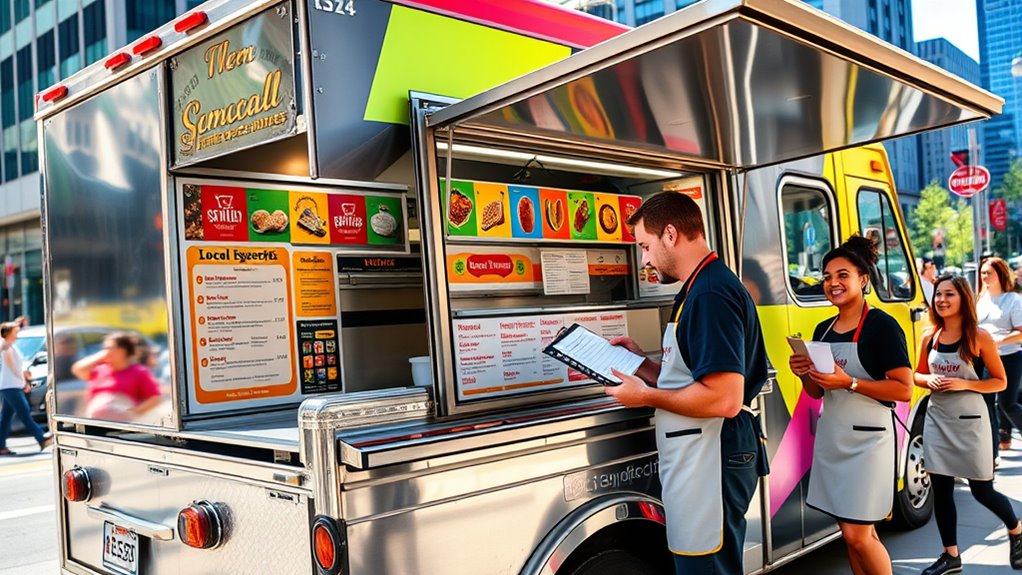
Ensuring food safety and compliance is essential for food trucks to operate successfully over the long term. Indiana’s statewide mobile retail food establishment license, effective in 2027, simplifies permits and aligns health inspections with brick-and-mortar standards. Local health departments will conduct twice-yearly inspections and handle licensing, with fees varying by locality—Westfield, for example, charges $150 annually. You’ll need temporary use permits for events, guaranteeing compliance during special occasions. Follow statewide food safety standards, including proper handling, storage, sanitation, and employee hygiene, verified through regular inspections. Additionally, Indianapolis is considering regulations on operating hours and zones to maintain safety. Staying current with training and maintaining detailed records will help you meet health requirements and ensure your truck’s long-term success.
Frequently Asked Questions
How Long Does the Permit Approval Process Typically Take in Indianapolis?
The permit approval process in Indianapolis usually takes about 1-3 weeks for standard vendor permits. If health inspections are needed, it can extend to 3-4 weeks, especially during busy seasons. Your application speed depends on how complete and accurate your documents are. Keep in mind, inspections and additional approvals like fire safety or commissary agreements can add to the timeline. Planning ahead helps guarantee a smoother approval process.
Are There Any Restrictions on Operating Mobile Food Trucks During Special Events?
Like a ship steering busy waters, you must steer clear of restrictions when operating during special events. You can’t set up too close to brick-and-mortar restaurants or in prohibited zones, and you’ll need permits for larger gatherings. Fire safety and sanitation rules are your lighthouse, guiding safe operations. Always check with event organizers for location rules and ensure your licenses are current, so your food truck sails smoothly through the event.
Can I Operate a Food Truck Without a Commissary in Indianapolis?
You can’t operate a food truck in Indianapolis without a commissary. Indiana law requires mobile units to use a licensed, inspected, and approved commissary for food prep, cleaning, waste disposal, and storage. Operating without one isn’t legal and can lead to permit revocation. You must either rent a shared commercial kitchen or establish your own, guaranteeing it meets all health department standards. This ensures your truck remains compliant and safe for customers.
What Are the Specific Parking Restrictions for Food Trucks on City Streets?
Imagine your food truck as a vessel traversing a busy river; you must follow the currents to avoid obstacles. You can’t block driveways, fire hydrants, or pedestrian crossings. Parking angles and time limits are like the river’s rapids—must be respected. Always check for specific city rules, obtain necessary permits, and honor parking restrictions to keep your journey smooth and avoid penalties in Indianapolis.
Are There Any Seasonal Limitations or Weather Considerations for Food Truck Operation?
You should consider seasonal limitations and weather when operating your food truck. Warm months, from May to October, are ideal due to better weather and higher event activity, but winter brings challenges like cold temperatures, snow, and wind, which can affect customer turnout. You’ll need weather-appropriate equipment, such as heaters and weatherproofing, and plan for potential permit restrictions or safety measures during off-peak seasons to stay compliant and safe.
Conclusion
Starting your food truck journey in Indianapolis isn’t just about permits or menus; it’s about embracing the vibrant street scene and making your mark. With careful planning, smart marketing, and a passion for great food, you’ll turn wheels into wonder and streets into stages. Remember, every step you take is a beat in your success story—so keep moving forward, stay committed, and let your culinary dreams roll on, unstoppable and unstoppable.
